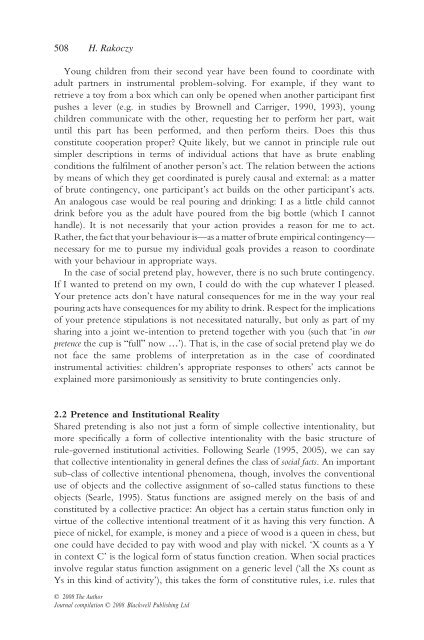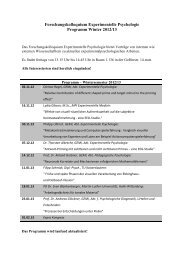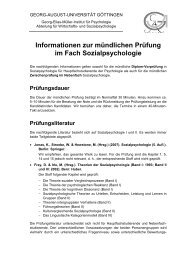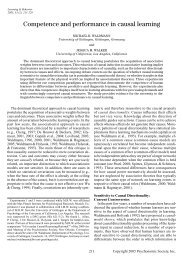Pretence as Individual and Collective Intentionality
Pretence as Individual and Collective Intentionality
Pretence as Individual and Collective Intentionality
You also want an ePaper? Increase the reach of your titles
YUMPU automatically turns print PDFs into web optimized ePapers that Google loves.
508<br />
H. Rakoczy<br />
Young children from their second year have been found to coordinate with<br />
adult partners in instrumental problem-solving. For example, if they want to<br />
retrieve a toy from a box which can only be opened when another participant fi rst<br />
pushes a lever (e.g. in studies by Brownell <strong>and</strong> Carriger, 1990, 1993 ), young<br />
children communicate with the other, requesting her to perform her part, wait<br />
until this part h<strong>as</strong> been performed, <strong>and</strong> then perform theirs. Does this thus<br />
constitute cooperation proper? Quite likely, but we cannot in principle rule out<br />
simpler descriptions in terms of individual actions that have <strong>as</strong> brute enabling<br />
conditions the fulfi lment of another person ’ s act. The relation between the actions<br />
by means of which they get coordinated is purely causal <strong>and</strong> external: <strong>as</strong> a matter<br />
of brute contingency, one participant ’ s act builds on the other participant ’ s acts.<br />
An analogous c<strong>as</strong>e would be real pouring <strong>and</strong> drinking: I <strong>as</strong> a little child cannot<br />
drink before you <strong>as</strong> the adult have poured from the big bottle (which I cannot<br />
h<strong>and</strong>le). It is not necessarily that your action provides a re<strong>as</strong>on for me to act.<br />
Rather, the fact that your behaviour is — <strong>as</strong> a matter of brute empirical contingency —<br />
necessary for me to pursue my individual goals provides a re<strong>as</strong>on to coordinate<br />
with your behaviour in appropriate ways.<br />
In the c<strong>as</strong>e of social pretend play, however, there is no such brute contingency.<br />
If I wanted to pretend on my own, I could do with the cup whatever I ple<strong>as</strong>ed.<br />
Your pretence acts don ’ t have natural consequences for me in the way your real<br />
pouring acts have consequences for my ability to drink. Respect for the implications<br />
of your pretence stipulations is not necessitated naturally, but only <strong>as</strong> part of my<br />
sharing into a joint we-intention to pretend together with you (such that ‘ in our<br />
pretence the cup is “ full ” now … ’ ). That is, in the c<strong>as</strong>e of social pretend play we do<br />
not face the same problems of interpretation <strong>as</strong> in the c<strong>as</strong>e of coordinated<br />
instrumental activities: children ’ s appropriate responses to others ’ acts cannot be<br />
explained more parsimoniously <strong>as</strong> sensitivity to brute contingencies only.<br />
2.2 <strong>Pretence</strong> <strong>and</strong> Institutional Reality<br />
Shared pretending is also not just a form of simple collective intentionality, but<br />
more specifi cally a form of collective intentionality with the b<strong>as</strong>ic structure of<br />
rule-governed institutional activities. Following Searle (1995, 2005) , we can say<br />
that collective intentionality in general defi nes the cl<strong>as</strong>s of social facts . An important<br />
sub-cl<strong>as</strong>s of collective intentional phenomena, though, involves the conventional<br />
use of objects <strong>and</strong> the collective <strong>as</strong>signment of so-called status functions to these<br />
objects ( Searle, 1995 ). Status functions are <strong>as</strong>signed merely on the b<strong>as</strong>is of <strong>and</strong><br />
constituted by a collective practice: An object h<strong>as</strong> a certain status function only in<br />
virtue of the collective intentional treatment of it <strong>as</strong> having this very function. A<br />
piece of nickel, for example, is money <strong>and</strong> a piece of wood is a queen in chess, but<br />
one could have decided to pay with wood <strong>and</strong> play with nickel. ‘ X counts <strong>as</strong> a Y<br />
in context C ’ is the logical form of status function creation. When social practices<br />
involve regular status function <strong>as</strong>signment on a generic level ( ‘ all the Xs count <strong>as</strong><br />
Ys in this kind of activity ’ ), this takes the form of constitutive rules, i.e. rules that<br />
© 2008 The Author<br />
Journal compilation © 2008 Blackwell Publishing Ltd











